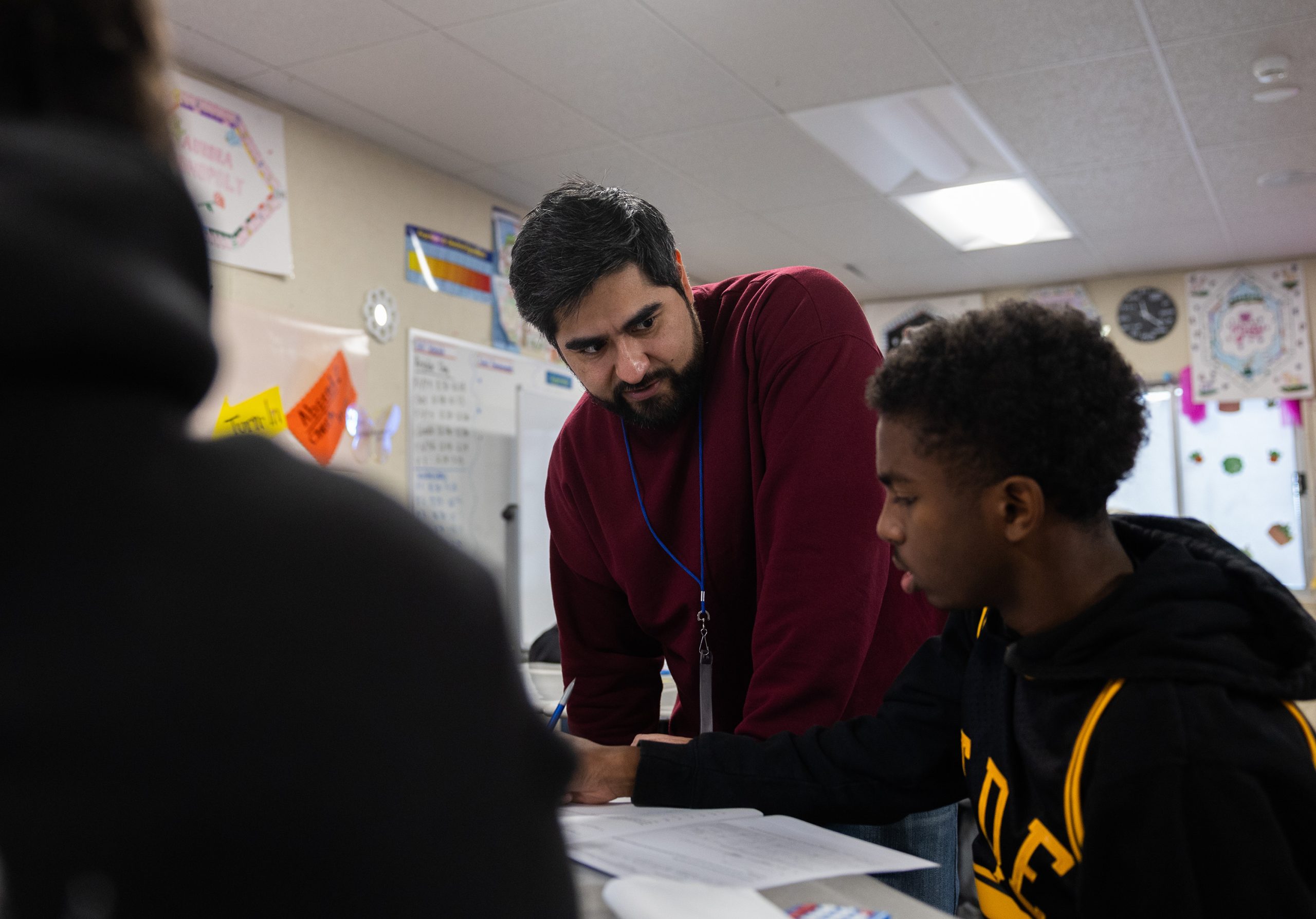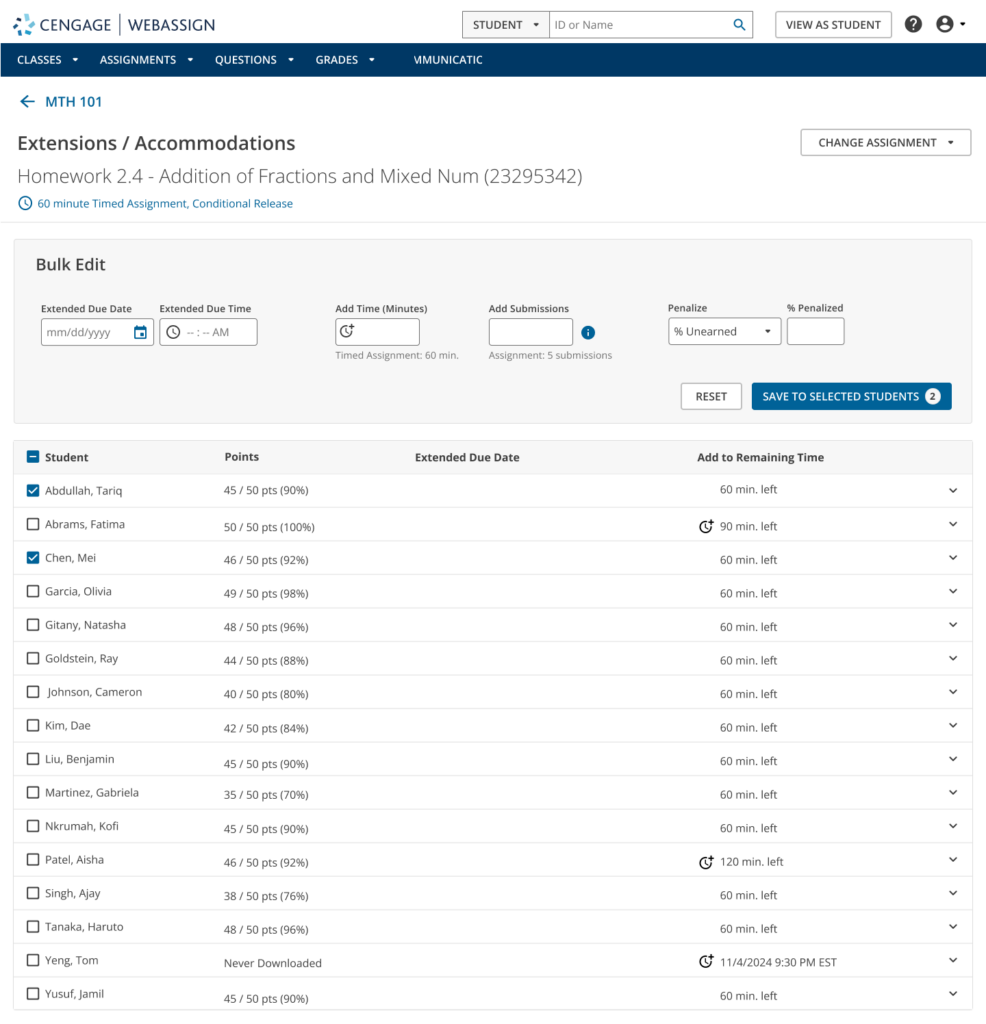A panel of experts, led by University of Technology Sydney deputy-vice-chancellor Kylie Readman, discussed the importance of online learning in the latest episode of HEDx.
Please login below to view content or subscribe now.
Membership Login

A panel of experts, led by University of Technology Sydney deputy-vice-chancellor Kylie Readman, discussed the importance of online learning in the latest episode of HEDx.
Please login below to view content or subscribe now.

In-person lectures have been a staple of university learning for centuries.
Please login below to view content or subscribe now.

After graduating from Knox College in Illinois with a bachelor’s degree, Stephanie Martinez-Calderon’s plans were upended by the pandemic. She hadn’t planned on becoming a teacher but found an opportunity to tutor remotely for the year after college.
Tutoring helped her build confidence and develop instructional skills, and today she’s a middle school teacher in the Washoe County School District in Nevada.
Tutoring can be a powerful training ground for future educators, providing hands-on experience, confidence and a bridge into the classroom. And what might begin as a temporary opportunity can become a career path at a time when teachers are needed more than ever: A recent report noted that nearly one in five K-12 teachers plan to leave teaching or are unsure if they’ll stay.
Turnover remains a crisis in many districts, one that can be solved by a ready-made pipeline of young future educators with instructional experience and relationship-building skills they’ve gained from tutoring.
Related: A lot goes on in classrooms from kindergarten to high school. Keep up with our free weekly newsletter on K-12 education.
How school districts think about tutoring should evolve. Rather than seeing it as a short-term response to pandemic-interrupted learning, they should view it as part of the fabric of school design and future educator development. This requires including tutoring in strategic plans, forming community partnerships and creating a structure to sustain programs that cultivate tutors for careers in education. To fund these programs and pay tutors, districts can redirect Title I funds, use federal work-study and create apprenticeship programs.
Starting as a tutor allows aspiring educators to build core teaching skills in a supportive, lower-stakes environment. Tutors learn to navigate student relationships and adapt lessons to individual needs. Without having to manage an entire classroom, they can practice asking questions that get students thinking and selecting problems to help students learn. This early practice eases the transition into teaching.
Tutors from Generation Z, born between 1996 and 2012, often bring fresh energy to the profession. As digital natives, they are reimagining how to engage and inspire students, leverage technology and foster creativity and new approaches to learning.
They are also the most ethnically and racially diverse generation yet: Many come from backgrounds historically underrepresented in the teaching force; over half of undergraduates identify as first-generation college students. Their engagement broadens the prospects for a more diverse teacher pipeline.
Tutor recruiters have noticed that Gen Z workers don’t just want a job — they want roles committed to social impact, professional growth and sustainable work-life balance.
Gen Z’s emphasis on flexibility and remote opportunities is one of the most significant workforce changes since the pandemic. They value mental health, stability and mission-driven work. Part-time, hybrid and wellness benefits help recruit young talent.
At our nonprofit, recruiters hear from education candidates that Gen Z appreciates the chance to try out industries, and that tutoring provides them with a window into the world of teaching.
Public schools could better meet the evolving needs of young professionals entering education by reimagining tutor roles to include hybrid options, mental health supports and collaborative teaching pathways for professional growth. For instance, a tutor might start off working in a part-time online tutoring role, but after interacting with students virtually and gaining more experience, they may be more excited to take on a full-time teaching role on-site.
For school districts, tutoring programs can serve as effective recruitment pipelines. By offering recent graduates a low-barrier entry point into education — one that doesn’t require immediate certification — districts can spark interest in teaching among candidates who may not have previously considered it.
Amid ongoing hiring challenges, particularly mid-year vacancies, tutors can offer timely solutions.
When tutors step into teaching roles, they bring valuable continuity — familiarity with the students and insight into progress and school culture. This seamless transition supports both student learning and district staffing needs.
Related: PROOF POINTS: Taking stock of tutoring
The idea that tutoring should be built into future educator pipelines is spreading. For example, since the launch of its Ignite Fellowship in 2020, Teach for America says that 550 of its former tutors have become full-time teachers. The program has proven to be especially effective at drawing in nontraditional candidates — those who may not have initially envisioned themselves in the classroom. In Washington, D.C., the school district launched a tutor-to-teacher apprenticeship program after success with high-impact tutoring. In Texas, teacher residents are required to work as tutors and in other support roles while co-teaching with a mentor.
By offering flexible, purpose-driven opportunities, districts can attract Gen Z professionals and give them a meaningful entry point into teaching. And tutoring programs can become more than academic support — they can serve as strategic talent pipelines that strengthen the future of the teaching workforce.
Alan Safran is co-founder, CEO and chair of the board of Saga Education; Halley Bowman is senior director of academics.
Contact the opinion editor at [email protected].
This story about tutoring was produced by The Hechinger Report, a nonprofit, independent news organization focused on inequality and innovation in education. Sign up for Hechinger’s weekly newsletter.

Key points:
During the height of the COVID-19 outbreak, teachers needed to become resourceful in how they delivered content to students. During this time, students experienced significant change and evolved into a more technologically-dependent group.
This sparked a period when online learning and digital resources gained substantial popularity, and one tool that helps students learn–while also feeling like a game instead of a lesson–is Gimkit.
I am an 8th-grade science teacher in a fairly large district, and I recognize the importance of these engaging and interactive resources to help students build knowledge and continue learning.
What is Gimkit?
To begin with, what is Gimkit? According to a tutorial, “Gimkit is an excellent game-based learning platform that combines fun and education, making it a highly engaging tool for both teachers and students. It works like a mashup of Kahoot and flash card platforms, but with several unique features that set it apart.
“Unlike other platforms, Gimkit allows students to earn virtual currency for every correct answer, which they can use to purchase power-ups, adding a competitive edge that keeps students motivated.”
Gimkit offers so much more than just a game-based learning experience for students–it can be used as an introduction to a lesson, as assigned homework, or as a tool for reviewing.
Building a Gimkit
From the teacher’s side of Gimkit, the platform makes it extremely easy to build lessons for the students to use. When you go to create a lesson, you are given many different options to help with the construction.
Jamie Keet explains: “After establishing your basic Kit information, you will then move onto the fun part–adding your questions! You will be given the option of adding a question, creating your Kit with Flashcards, continuing with KitCollab, adding from Gimkit’s Question Bank, or importing from Spreadsheet.”
Adding your questions is a great way to make sure your students are getting the exact information they have been provided in class, but some of the other options can help with a teacher’s time, which always seems to be scarce.
The option to add questions from the question bank allows teachers to view other created kits similar to their topic. With a few simple clicks, a teacher can add questions that meet the needs of their lesson.
Gimkit as data collection
Gimkit isn’t just a tool for students to gain knowledge and play games; it is also an excellent way for teachers to collect data on their students. As Amelia Bree observes:
“Gimkit reports explained show you both big pictures and small details. The look might change sometimes. But you will usually see:
Being able to see this data can help ensure that your students are not just completing the required steps to finish the task, but are also working towards mastering the materials within your class.
When examining the data, if you identify trends related to specific questions or concepts that students are struggling with, you have the opportunity to revisit and reteach these areas.
Conclusion
As you can see, Gimkit isn’t just a tool for students to play games and have fun in class; it is also an opportunity for students to gain knowledge in your lessons while potentially having some fun in the process. Teachers can make creating content for their classes much easier by utilizing some of the built-in features Gimkit provides.
They can collect the meaningful data needed to ensure students are making progress in the areas where they want them to.
Works Cited
Breisacher, J. (2024, October 7). How Teachers Can Use Gimkit in the Classroom (a tutorial). Student-Centered World. https://www.studentcenteredworld.com/gimkit/
Keet, J. (2021, July 9). How to Use Gimkit- Step By Step Guide. Teachers.Tech.
https://teachers.tech/how-to-use-gimkit/
Bree, E. (2025, June 6). Unlock Data-Driven Teaching: Using Gimkit for Meaningful
Assessment Insights. GIMKIT JOIN.
https://gimkitjoin.net/gimkit-for-meaningful-assessment-insights/

Digital platforms are a key part of a positive student experience and will be a major focus for the new Adelaide University (AU), its digital project lead told an audience of academics on Thursday.
Please login below to view content or subscribe now.

Higher education is evolving and, as someone deeply involved in curriculum development, I have witnessed firsthand how virtual-hybrid delivery models can transform learning experiences. When the COVID-19 pandemic necessitated a sudden shift in instructional methods, I had to reconsider how to deliver my senior-level undergraduate Entrepreneurial Thinking and Innovation course, which was traditionally taught face-to-face (F2F). What started as a necessary adaptation quickly became an opportunity to enhance student engagement, flexibility, and real-world preparedness. I now recognize that virtual-hybrid delivery is not merely a temporary fix, but a sustainable and highly effective model for the future of education across disciplines.
My Entrepreneurial Thinking and Innovation course was originally designed around a hands-on, project-based learning (PBL) approach. At the course’s core was a semester-long, stage-gated Business Case, or BizCase Project. Student teams tackled real-world business challenges by developing comprehensive business cases for community organizations. Traditionally, this involved in-person collaboration, real-time feedback, and instructor-led sessions.
When we shifted to online learning, my primary challenge was to preserve the course’s interactive and applied nature, while using digital tools to maintain engagement. Rather than attempting to replicate the in-person experience, I completely reimagined the learning process.
The revamped course focused on three key elements:
The impact of this redesign was immediate and profound. Not only did students stay engaged, but their learning outcomes improved significantly. The average final grades on the BizCase Project increased by 8-10% compared to previous face-to-face cohorts. Here’s why this delivery model is so effective:
One of the most significant advantages of virtual-hybrid learning is the combination of structured flexibility and active engagement. Traditional lecture formats often lead to passive learning. The virtual-hybrid approach inspires students to take charge of their educational journey, thereby enhancing learner agency.
Synchronous milestone meetings ensured students remained accountable and on track, while asynchronous videos allowed them to review content at their own pace. Many students observed that revisiting instructional videos before project discussions greatly boosted their comprehension and confidence.
Virtual-hybrid delivery reflects the realities of modern workplaces, where professionals are increasingly engaged in hybrid and remote work environments. By embracing this model, students acquire academic knowledge while developing essential skills in virtual collaboration, digital communication, and self-directed learning.
The course redesign was based on industry research regarding optimal meeting structures, which indicates that smaller, focused discussions promote greater engagement and enhance problem-solving. I implemented smaller team-based milestone meetings instead of large, passive online lectures, ensuring each student actively participated. This change aligns with corporate best practices. It equips students with skills that are directly transferable to contemporary work environments.
One of the most significant innovations in this course redesign was using screencast technology for project feedback. Rather than traditional written comments, students received comprehensive, video feedback. I guided them through their submissions, emphasizing strengths and areas for improvement. Students overwhelmingly preferred this method, with 90% indicating that video feedback was clearer and more personal than written comments. The combination of seeing and hearing the feedback, along with visual annotations, created a more interactive and engaging learning experience, making it easier for students to refine their work.
While virtual-hybrid learning offers significant benefits, it also presents challenges. Although students appreciated the flexibility of self-paced videos, some struggled with motivation and time management in effectively navigating the course requirements.
Another challenge is ensuring equitable access to technology. Not all students have access to high-quality devices or reliable internet connections. This can affect their ability to engage fully in virtual-hybrid courses. Institutions must invest in digital infrastructure and support systems to ensure all students can participate effectively.
Although this article focuses on an entrepreneurship and innovation course, the principles of virtual-hybrid learning can be applied to various disciplines. This model can benefit any course, including experiential learning, teamwork, and applied projects.
The success of the virtual-hybrid delivery model in Entrepreneurial Thinking and Innovation underscores its remarkable potential. The one-size-fits-all, lecture-heavy educational approach is becoming obsolete. Today’s students thrive in dynamic, technology-enhanced environments that prepare them for hybrid workplaces and the future of work.
As educators, we have both an opportunity and a responsibility to rethink traditional teaching methods. Virtual-hybrid delivery presents a path forward for a more adaptable and impactful education. Having experienced the transformative effects of this approach firsthand, I can confidently assert that virtual-hybrid delivery can be a game changer for the future of higher education.

Inserting brief quiz questions into an online lecture can boost learning and may reduce racial achievement gaps, even when students are tuning in remotely in a distracting environment.
That’s a main finding of our recent research published in Communications Psychology. With co-authors Dahwi Ahn, Hymnjyot Gill and Karl Szpunar, we present evidence that adding mini-quizzes into an online lecture in science, technology, engineering or mathematics – collectively known as STEM – can boost learning, especially for Black students.
In our study, we included over 700 students from two large public universities and five two-year community colleges across the U.S. and Canada. All the students watched a 20-minute video lecture on a STEM topic. Each lecture was divided into four 5-minute segments, and following each segment, the students either answered four brief quiz questions or viewed four slides reviewing the content they’d just seen.
This procedure was designed to mimic two kinds of instructions: those in which students must answer in-lecture questions and those in which the instructor regularly goes over recently covered content in class.
All students were tested on the lecture content both at the end of the lecture and a day later.
When Black students in our study watched a lecture without intermittent quizzes, they underperformed Asian, white and Latino students by about 17%. This achievement gap was reduced to a statistically nonsignificant 3% when students answered intermittent quiz questions. We believe this is because the intermittent quizzes help students stay engaged with the lecture.
To simulate the real-world environments that students face during online classes, we manipulated distractions by having some participants watch just the lecture; the rest watched the lecture with either distracting memes on the side or with TikTok videos playing next to it.
Surprisingly, the TikTok videos enhanced learning for students who received review slides. They performed about 8% better on the end-of-day tests than those who were not shown any memes or videos, and similar to the students who answered intermittent quiz questions. Our data further showed that this unexpected finding occurred because the TikTok videos encouraged participants to keep watching the lecture.
For educators interested in using these tactics, it is important to know that the intermittent quizzing intervention only works if students must answer the questions. This is different from asking questions in a class and waiting for a volunteer to answer. As many teachers know, most students never answer questions in class. If students’ minds are wandering, the requirement of answering questions at regular intervals brings students’ attention back to the lecture.
This intervention is also different from just giving students breaks during which they engage in other activities, such as doodling, answering brain teaser questions or playing a video game.
Online education has grown dramatically since the pandemic. Between 2004 and 2016, the percentage of college students enrolling in fully online degrees rose from 5% to 10%. But by 2022, that number nearly tripled to 27%.
Relative to in-person classes, online classes are often associated with lower student engagement and higher failure and withdrawal rates.
Research also finds that the racial achievement gaps documented in regular classroom learning are magnified in remote settings, likely due to unequal access to technology.
Our study therefore offers a scalable, cost-effective way for schools to increase the effectiveness of online education for all students.
We are now exploring how to further refine this intervention through experimental work among both university and community college students.
As opposed to observational studies, in which researchers track student behaviors and are subject to confounding and extraneous influences, our randomized-controlled study allows us to ascertain the effectiveness of the in-class intervention.
Our ongoing research examines the optimal timing and frequency of in-lecture quizzes. We want to ensure that very frequent quizzes will not hinder student engagement or learning.
The results of this study may help provide guidance to educators for optimal implementation of in-lecture quizzes.
The Research Brief is a short take on interesting academic work.
This article is republished from The Conversation under a Creative Commons license. Read the original article.

As a professor, I specifically use education TeachSource videos located in the MindTap Learning Path to enhance online lectures and provide students with a “hands-on learning” component.
However, my students were neither engaging in assignment completion nor providing full answers. Then, I had an “aha” moment, highlighting a common challenge in online education: students need to move beyond surface-level responses towards deeper analytical engagement. My mindset changed from teaching to mentorship.
To foster genuine analytical thinking in application assignments — especially relating to real-life experiences — I’d consider the following approaches in combination with the use of TeachSource videos:
Instead of questions that can be answered with one or two sentences, or mere definitions, frame prompts around real-world scenarios that require students to analyze, evaluate, and apply concepts. For example, in my early childhood education courses using MindTap, I ask students to: “Describe a situation in your classroom or community where you encountered a child throwing a tantrum over something they wanted which was not in their best interest — aka: noting a specific concept which is applicable. How would you address the challenges in this video situation using what you have learned in this chapter?”
As the previous example states, ask students to connect theory with personal experiences or current events. This invites them to reflect critically and relate abstract ideas to concrete situations, deepening understanding. In teaching and learning, we call this reflective thinking. This involves critically analyzing one’s own thought processes and experiences to deepen understanding. In the end, educational psychology tells us that the transfer of learning applies abstract ideas or principles to concrete, real-world situations. This enables learners to generalize knowledge beyond the original context. Together, these processes help learners deepen their understanding by connecting theory with practice through critical reflection.
We understand that our students might be at different levels when it comes to understanding a theory or concept. So, how do we use TeachSource videos to share teaching concepts?
Start with pre-assessment questions of basic application. In basic application, you identify what the learner’s knowledge of the concept in the video is.
Then, progress towards deeper analysis. For example:
Role playing is a concept that’s important to scaffolding the “transfer of learning.” For example, a future education student is wired with curiosity to imagine what their classroom will look like and how they will interact with future students. Instructors can create this experience for them in a variety of ways. Linking our teaching of real-life experiences to standards of learning provides the opportunity for instructors to role play. It provides the opportunity to fail and learn from real world mistakes. Therefore, students can develop more marketable skill sets.
We discussed role playing, but how do we link real life to workforce standards using TeachSource MindTap videos? In my early childhood course, I link all course concepts to the National Association for the Education of the Young Child (NAEYC) Professional Standards. This process begins in the syllabus but also in the course shell modules built around MindTap. By doing so, students can see themselves as future employees.
In conclusion, closing the learning process gap means we teach with purpose and in a systematic cycle. Therefore, my teaching has become a cycle of learning, rather than just a video assignment linked to chapter information. MindTap TeachSource videos happen to be my vehicle for the transfer of learning.
Dr. Maria C. Rutherford is a Full Professor at Bluegrass Community and Technical College and Cengage Faculty Partner.

We know how much you do to support your students, and we want to make it easier for you to give them the help they need, when they need it. That’s why we’re releasing improvements to accommodations and extensions in WebAssign — so you can manage student requests efficiently and save time throughout your course.
Let’s dive into what’s coming.
It can be challenging to manage accommodation requests for extended time at the start of classes. We’re introducing a new feature that makes this process so much easier, allowing you to grant extra time to one or more students directly from your course roster.
Once applied, this setting will ensure that students who need additional time automatically receive it on all timed assignments. There’s no need for repeated manual adjustments to individual assignments. This change makes it easier to support your students, while saving you time.
“These [upgrades] will improve the amount of time I currently spend managing WebAssign each term for hundreds of students. Reducing the number of clicks and tabs I need to open is a huge change. Bulk extensions are a significant advancement in my mind.” – Kathleen Koenig, University of Cincinnati
But what if your students don’t have an accommodation, but need an extra 10 minutes or an extra day to work on their assignment?
Students often request extensions, extra time, additional submissions or even early access to assignments. To help you manage these requests more efficiently, we’re redesigning the manual extensions process with a more user-friendly interface and added flexibility.
With the new extension improvements, you’ll be able to:
And later, you’ll be able to grant early access to assignments for specific students.

These updates to WebAssign accommodations and extensions are just the beginning. We’re committed to continuously improving your experience and will have even more enhancements coming in the next phase of extension updates. We encourage you to stay tuned for what’s to come.

Let’s be real — online teaching isn’t about dumping lecture notes into a learning system and calling it a day. If we want students to actually engage, grow and retain what we teach, we’ve got to meet them where they are with tools and strategies that turn passive screens into powerful learning spaces.
This is at the heart of our Spring 2025 Empowered Educator recorded webinar session, “Interactive Learning Redefined With A.I.”
During our session, we explored tools and mindsets that make all the difference, whether you’re just starting as an educator or looking to breathe new life into your virtual classroom.
We’re teaching in an era where attention spans are short, expectations are high and personalization is the norm. Students don’t just want to listen. They want to participate, problem-solve and feel seen. The combination of interactive learning and Generative AI (GenAI) makes this not only possible, but sustainable.
Forget static slides. The key is giving students something to do, not just something to watch. Some of the most effective, real-time strategies listed in the CID Quick Tip Guide were explored during our session:
This kind of learning keeps things dynamic, allows for quick feedback and, best of all, shows students you’re in it with them.
Now, here’s where we level up. AI isn’t just about automation — it’s about tailoring the learning journey to meet each student where they are. In our session, we explored ways to:
It’s like having a digital co-teacher who’s always ready to personalize.
We also dove into case studies and data from real classrooms where these approaches led to:
When students feel included and in control of their learning, outcomes naturally improve.
In the end, this isn’t just about tools or tech. It’s about creating experiences where students feel challenged, supported and seen.
Watching this session on transforming student engagement in the online classroom will more than inspire you. You’ll learn how to:
Let’s create classrooms that aren’t just digital — but dynamic.
Written by Dr. Clevester Moten, Business Instructor at Jackson College and James Bender, Adjunct Instructor at Jackson College.
Dr. Clevester Moten is a transformative educator, scholar and thought leader whose research and work focus on equity, leadership and systemic reform. With more than 20 years of leadership spanning public, private and nonprofit sectors, he specializes in fostering collaboration and addressing societal challenges. Dr. Moten holds advanced degrees in public policy and business administration.